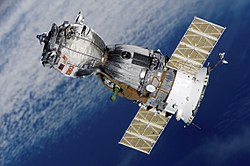| COSPAR ID | 1987-104A |
|---|---|
| SATCAT no. | 18699 |
| Mission duration | 178 days, 22 hours, 54 minutes, 29 seconds |
| Orbits completed | ~2,890 |
| Spacecraft properties | |
| Spacecraft | Soyuz 7K-STM No. 54 |
| Spacecraft type | Soyuz-TM |
| Manufacturer | NPO Energia |
| Launch mass | 7,070 kilograms (15,590 lb) |
| Crew | |
| Crew size | 3 |
| Launching | Vladimir Titov Musa Manarov Anatoli Levchenko |
| Landing | Anatoly Solovyev Viktor Savinykh Aleksandr Aleksandrov |
| Callsign | Okean (Ocean) |
| Start of mission | |
| Launch date | 21 December 1987, 11:18:03 UTC |
| Rocket | Soyuz-U2 |
| Launch site | Baikonur 1/5 |
| End of mission | |
| Landing date | 17 June 1988, 10:12:32 UTC |
| Landing site | 180 kilometres (110 mi) SE of Dzhezkazgan |
| Orbital parameters | |
| Reference system | Geocentric |
| Regime | Low Earth |
| Perigee altitude | 337 kilometres (209 mi) |
| Apogee altitude | 357 kilometres (222 mi) |
| Inclination | 51.6 degrees |
| Period | 91.5 minutes |
| Docking with Mir [1] | |
| Docking date | 23 December 1987, 12:51:00 UTC |
| Undocking date | 17 June 1988, 06:20:50 UTC |
 Soyuz programme (Crewed missions) | |
Soyuz TM-4 was a crewed Soyuz spaceflight to Mir. It was launched on 21 December 1987, and carried the first two crew members of the third long duration expedition, Mir EO-3. These crew members, Vladimir Titov and Musa Manarov, would stay in space for just under 366 days, setting a new spaceflight record. The third astronaut launched by Soyuz TM-4 was Anatoli Levchenko, who returned to Earth about a week later with the remaining crew of Mir EO-2. Levchenko was a prospective pilot for the Soviet Space shuttle Buran . The purpose of his mission, named Mir LII-1, was to familiarize him with spaceflight. [2]
Contents
It was the fourth Soyuz TM spacecraft to be launched (one of which was uncrewed), and like other Soyuz spacecraft, it was treated as a lifeboat for the station's crew while docked. In June 1988, part way through EO-3, Soyuz TM-4 was swapped for Soyuz TM-5 as the station's lifeboat. The mission which swapped the spacecraft was known as Mir EP-2, and had a three-person crew. [3]

